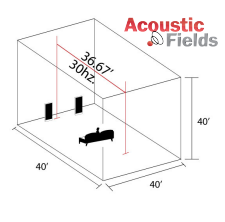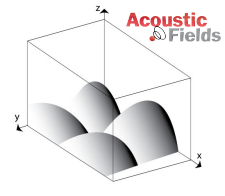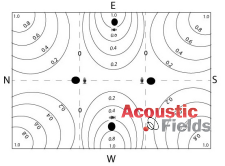It’s the time of year for saving money!
The energy produced by our hi-fi systems can be broken down into two categories. These categories of energy are based upon the length of the wave or ray. A wave, for purposes of this discussion, will be all energy below 200 cycles and rays representing all energy above 200 Hz. Waves of energy produce unwanted pressure areas within our rooms because they are long and don’t fit. Rays exist as reflections and bounce off of all our room surfaces producing reverberation. Both unwanted pressure and excessive reflections must be managed correctly, no matter what else is going on within our living/listening rooms.
 Wavelength
Wavelength
Let’s look at wavelength. A 200 Hz wave is 5.6 feet long. It is long enough to form unwanted high- and low-pressure areas within our rooms. It has enough acoustic horsepower to produce resonances. How it does this is a topic for another discussion. A 30 Hz wave is 38 feet long. One can easily see that this wavelength will have issues fitting almost anywhere in today’s smaller living rooms.
Size and Volume
Room size and volume are the major determinants of what frequency pressure issues you will have, how strong they will be and where they will be located. Room width, height and length all contribute to certain wavelengths fitting or not fitting into the given dimensions. In today’s small rooms, most frequencies below 200 Hz do not fit well at all. This discomfort is expressed in areas of high- and low-pressure patterns that cover the entire room interior and in some cases even the room exterior. These pressure areas can impact sound quality.
Room Modes
 Unwanted pressure in our living/listening rooms produces room modes. Room modes are areas of both low and high pressure. These modal areas are determined by the way the sound wavelengths fit the room dimensions. If the wavelengths correspond to the room dimensions, it creates unwanted peaks and dips in our frequency response. These peaks and dips smother and blur other frequencies to the point that they are over-represented or not heard of at all. We sure do not want or need that.
Unwanted pressure in our living/listening rooms produces room modes. Room modes are areas of both low and high pressure. These modal areas are determined by the way the sound wavelengths fit the room dimensions. If the wavelengths correspond to the room dimensions, it creates unwanted peaks and dips in our frequency response. These peaks and dips smother and blur other frequencies to the point that they are over-represented or not heard of at all. We sure do not want or need that.
Wave Treatment
 You need to use sound-absorbing technology that will work well with sound pressure within the front of your room. Contrary to widespread acoustical literature, foam and boxes filled with building insulation will not be that effective in your front room high-pressure area. You need pressure reactive technology that only membrane, diaphragmatic, and Helmholtz absorbers can produce. Applying the correct amount and types of acoustic materials in the right locations is paramount in order to achieve the correct rates and levels of absorption required for low-frequency wave definition and separation.
You need to use sound-absorbing technology that will work well with sound pressure within the front of your room. Contrary to widespread acoustical literature, foam and boxes filled with building insulation will not be that effective in your front room high-pressure area. You need pressure reactive technology that only membrane, diaphragmatic, and Helmholtz absorbers can produce. Applying the correct amount and types of acoustic materials in the right locations is paramount in order to achieve the correct rates and levels of absorption required for low-frequency wave definition and separation.
Subwoofers
Subwoofers are large energy-producing devices at lower frequencies. One subwoofer can create so much excess low-frequency energy within our living/listening rooms that it may seem all you can hear in certain musical passages is low frequencies. “Bass boom” is the slang for this phenomenon. “Mud” or “soup” also come to mind. Whatever the term, it is not wanted and positioning of a subwoofer is critical.
Location, Location, Location
 With a single subwoofer or especially with multiple units, location is critical. Since a subwoofer produces energy that mostly will not fit into today’s small rooms, you must place the subwoofer in an area of the room that will not produce unwanted energy accumulation. You can position a unit on the floor. You can raise it off the floor and calculate the correct height based upon room size and volume. You can position more toward room center or use a room boundary approach. All subwoofer positioning is dependent upon room size and volume.
With a single subwoofer or especially with multiple units, location is critical. Since a subwoofer produces energy that mostly will not fit into today’s small rooms, you must place the subwoofer in an area of the room that will not produce unwanted energy accumulation. You can position a unit on the floor. You can raise it off the floor and calculate the correct height based upon room size and volume. You can position more toward room center or use a room boundary approach. All subwoofer positioning is dependent upon room size and volume.
Pressure Release Valves
Doors or archways into other rooms can act as “pressure relief valves” and allow for energy to leave and enter the other structures within your house. This may be desired, but most of the time it is not wanted by the other members of the household. However, the ability for excess sound pressure to be able to migrate from an area of high pressure to one of lower pressure within the next room can smooth out even the strongest peaks in a room response curve. This is not an option with rays of energy which require uninterrupted surface areas for maximum treatment effectiveness.
Waves
Waves of energy that live in the below 200 Hz range produce lots of unwanted pressure in today’s small living/listening rooms. The amount and position of this unwanted room pressure is directly related to room size and volume, along with the actual length of the wave or frequency of energy. Pressure exists along room boundary surfaces and even into the room center. Speaker and listening positions must take heed of these areas and treat or avoid them completely. Following these and a few other must-do’s when setting up your living/listening area will get you much closer to your music and sonic goals.





